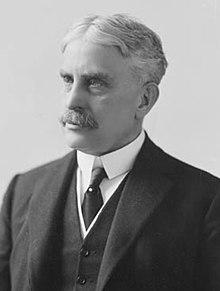
 behavior
behavior
Discover the fascinating evolution of the Canadian 100-dollar bill! As one of the higher denominations in circulation, this bill has undergone multiple changes to reflect the dynamic nature of Canadian society.
Dive into the history and design of this iconic currency. Keep reading to unveil the story behind the Canadian 100-dollar bill.
Disclosure: My site is reader-supported. I may get commissions when you click through the affiliate links (that are great products I use and stand by) on my articles.

100 Dollar Bill Canada
- Discover the fascinating evolution of the Canadian 100-dollar bill! As one of the higher denominations in circulation, this bill has undergone multiple changes to reflect the dynamic nature of Canadian society.
- Dive into the history and design of this iconic currency. Keep reading to unveil the story behind the Canadian 100-dollar bill.
A Closer Look Of The 100 Dollar Bill Canada
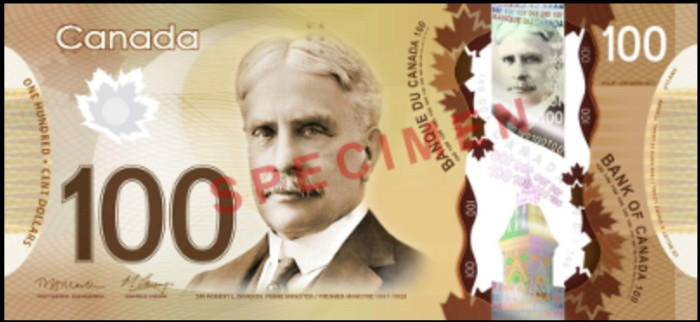
Frontal Perspective
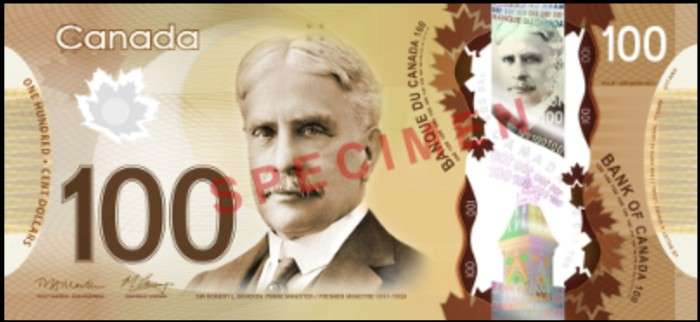
Opposite Perspective
Credit – Wikipedia
The impressive Canadian 100-dollar bill is an exquisite banknote issued by the Bank of Canada, the country’s central bank. This high-value currency is ideal for major transactions and big-ticket purchases.
It was introduced in November 2011 as part of the innovative Polymer series, the current version of the Canadian 100-dollar bill boasts a cutting-edge polymer substrate, replacing traditional paper.
This advanced material ensures superior durability and strengthens the bill’s resistance against counterfeiting attempts.
Gracing the front of the bill is the striking portrait of Sir Robert Borden, the eighth Prime Minister of Canada (1911-1920).
But the beauty doesn’t even stop there. The Canadian 100-dollar bill is fortified with numerous security features to safeguard its integrity.
These security measures include eye-catching holographic stripes, tactile raised printing, and a see-through window. Within this transparent window, carefully crafted design elements, such as a metallic portrait of Sir Robert Borden, come to life when exposed to ultraviolet light.
Forgery of the $100 bill
Take a look at the ancient 100-dollar bill, we will still talk about how it came into existence and the story behind it
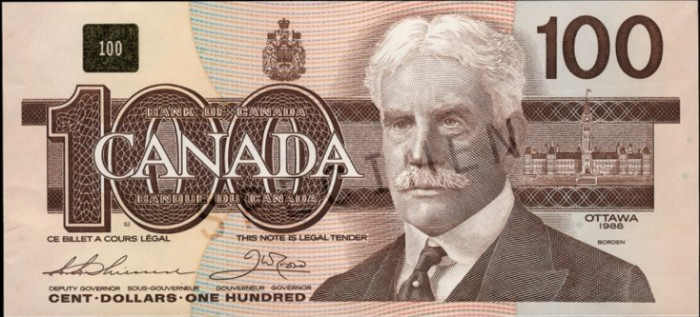
Overview
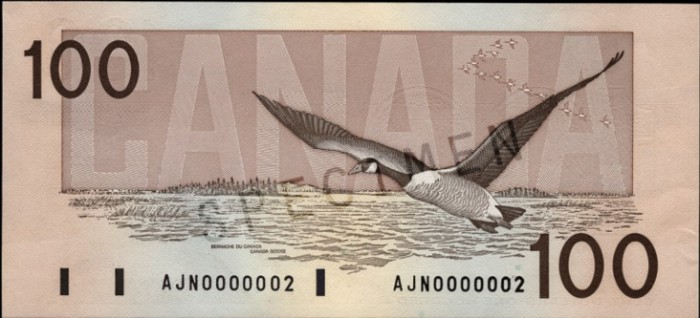
Back View
Source- Bank of Canada Museum
Retailers in Ontario and Quebec, back in 2001, had a major issue with counterfeit Canadian 100-dollar bills from the “Birds of Canada” series. It got so bad that they had to temporarily stop accepting these bills for big purchases like beer and cigarettes.
Now, you may be thinking that the problem has been solved with the reissued bills that have advanced security features. However, it turns out that businesses like 7-11 are still hesitant to accept them. Why? Well, it’s because our behavior towards banknotes has changed.
You see, we now have so many digital payment options like simplii and koho where we can just tap and pay. And if we do need cash, we can easily get it in smaller denominations from ATMs. So really, the Canadian 100-dollar bill isn’t all that commonly used anymore.
If you do happen to come across a Canadian 100-dollar bill, it’s probably because someone gave it to you. But please, be careful about where it came from. There’s still a risk of getting a counterfeit bill. So make sure to be as cautious as retailers were back in the early to mid-2000s.
The Canada Goose: Canadian Bird
Did you know that the reverse of the old 100-dollar Canadian note features a majestic Canadian goose? It’s a fascinating story that most Canadians don’t know, but it’s definitely true.
On the back of the old 100-dollar Canadian note, you’ll find a stunning depiction of a goose in flight, gracefully soaring between two majestic mountains. This beautiful artwork was created by the talented artist, William Koochin, who took inspiration from the breathtaking natural beauty found in our country.
The choice to feature the Canadian goose on the 100-dollar bill was a deliberate one. These iconic geese can be seen all across Canada, making them a perfect symbol for unifying people from different regions of our country on the same banknote.
So, the next time you come across a 100-dollar Canadian note, take a moment to appreciate the hidden story behind the impressive Canadian goose on the reverse side.
Fascinating Information About Canada Geese
On the morning of September 22, 1995, a tragic event unfolded in the skies above Alaska. Little did the crew onboard the United States Air Force Boeing know that their flight to Elmendorf Air Force Base would take a deadly turn.
Unbeknownst to them, a massive group of Canadian Geese had made their home at the base and were out and about in search of food. As the plane made its way through the air, it encountered this flock of geese crossing its path. Despite attempts to avoid them, the plane collided with several birds, causing serious damage to its engines.
The crew fought desperately to regain control of the aircraft, but their efforts were in vain. The plane began to descend rapidly, hurtling towards the ground. The crash was devastating, resulting in the instant loss of all 24 people on board and shattering the lives of their families.
It’s a tragic reminder of the incredible power of these majestic birds, even though they too suffered casualties in this heartbreaking accident.
Properties of the Canadian 100 Dollar Bill
Check out the awesome features on the Canadian 100-dollar bill! These features aren’t just for looks, they enhance the security of the bill. Here’s what you’ll find:
- A cool portrait
- A famous building
- A scientist peering through a microscope
- Life-saving insulin
- The blueprint of life – a DNA strand
- The heartbeat of the bill – an electrocardiogram
Canada’s Eighth Prime Minister in Focus
Source – Wikipedia
Did you know that the Canadian 100-dollar bill showcases the portrait of Sir Robert Borden? He was Canada’s eighth prime minister and held office from 1911 to 1920.
Borden is one of just three Canadian Prime Ministers to be featured on a banknote, joining the ranks of Sir John A. Macdonald and Sir Wilfrid Laurier.
But why is Borden’s portrait on the 100-dollar bill? Well, it serves a couple of important purposes. Firstly, it pays tribute to Borden’s significant contributions to Canadian politics and his remarkable leadership during a crucial time in our history.

100 Dollar Bill Canada
- Discover the fascinating evolution of the Canadian 100-dollar bill! As one of the higher denominations in circulation, this bill has undergone multiple changes to reflect the dynamic nature of Canadian society.
- Dive into the history and design of this iconic currency. Keep reading to unveil the story behind the Canadian 100-dollar bill.
Borden and his contribution to the First World War
Borden was a key player in guiding Canada through World War I, and he accomplished some major things while he was at it. He helped establish the Canadian Navy, the Canadian Expeditionary Force, and the Canadian income tax system. Not too shabby!
But that’s not all. Borden’s portrait on the Canadian 100-dollar bill is more than just a nod to his accomplishments. It’s a symbol of Canada’s democracy and the importance of political leaders in shaping the nation.
Oh, and it’s not just for show. The portrait on the 100-dollar bill helps prevent counterfeiters and fraudsters from ripping off the good people of Canada. It’s designed with fancy colors and security features that make it really hard to copy. So you can feel secure knowing that your cash is the real deal.
The Building
Two talented architects, Thomas Stent and Augustus Laver, created stunning Gothic Revival buildings that are truly awe-inspiring.
Among their notable works is the East Block Tower, which was constructed in the 1860s and is prominently featured on the Canadian $100 bill.
For the first century of Canada’s government, the East Block was the heart of it all. Esteemed individuals such as Prime Minister Sir John A. Macdonald and Sir George-Étienne Cartier had their offices within this iconic block.
In 1910, an addition was made to the back of the East Block, featuring six impressive vaults that housed the country’s financial holdings. However, in the 1930s, the Bank of Canada acquired their own building, and the job of safeguarding the nation’s finances was transferred there.
Despite this change, the vaults in the East Block were repurposed into offices, preserving their original doors as a reminder of their former function.
Researcher at a Microscope
The new Canadian 100-dollar bill features a cool image of a scientist working with a microscope. This image represents Canada’s dedication to science and innovation, and how crucial research is for the country’s future.
Having the “Researcher at a Microscope” image on the Canadian 100-dollar bill has a few purposes.
Firstly, it pays tribute to the amazing work that scientists and researchers do in expanding our knowledge and understanding. Canada is home to some world-famous scientists and research institutions, and this image recognizes their contributions to scientific discovery and innovation.
Secondly, the image is a symbol of Canada’s commitment to education and learning. With top-notch universities and research institutions, Canada believes in the importance of education and training, helping people prepare for careers in science and beyond.
Production of Insulin
What if I tell you that the image of insulin on the Canadian 100-dollar bill represents an incredible scientific breakthrough? Canadian scientists Frederick Banting and Charles Best discovered and developed insulin as a life-saving treatment for diabetes. Their work has had a profound impact on millions of lives around the world.
But the inclusion of insulin on the banknote serves more than just a tribute to these amazing scientists. It’s also a symbol of Canada’s commitment to research and innovation. Canada has a rich history of making significant contributions to the fields of science and medicine, and the image of insulin showcases our country’s leadership in medical research.
And here’s something interesting: the image of insulin on the 100-dollar bill serves a practical purpose too. It helps prevent counterfeiting and fraud! The intricate combination of colors and security features used to print the image make it nearly impossible to reproduce. So not only is the banknote secure, but it’s also easily recognizable.
Anytime you see a Canadian 100-dollar bill, take a moment to appreciate the groundbreaking work of Banting and Best and the impact of insulin on the world. It’s a reminder of the power of scientific discovery and innovation.
DNA Strand
The DNA strand on the Canadian 100-dollar bill is more than just a symbol. It represents Canada’s dedication to scientific progress and its leading role in genetics.
This inclusion of the DNA strand on our banknote has a dual purpose. It pays tribute to the groundbreaking work of Canadian scientists like Frederick Sanger, who revolutionized DNA sequencing and advanced genetics.
By featuring the DNA strand, Canada acknowledges its significant contributions to genetic research. It also serves as a reminder of the powerful role genetics plays in our health and identity. Our DNA shapes everything from our appearance to our susceptibility to diseases.
On top of all that, the DNA strand on our 100-dollar bill adds a layer of security. It’s printed using a mix of colors and security measures that make it nearly impossible to counterfeit. So not only is it a symbol of Canada’s scientific prowess, it’s also a safeguard against fraud.
Overall, the image of a DNA strand on our banknote is a tribute to Canada’s scientific community, a testament to the importance of genetics, and a symbol of our commitment to progress and security.
Electrocardiogram

You might be wondering why there’s a medical symbol on a piece of money. Well, it turns out that this ECG represents Canada’s incredible contributions to the world of medical technology.
This little graphic is a big deal in the field of cardiology. You see, an ECG is a super important tool that helps doctors diagnose and treat heart disease. And boy, does Canada know a thing or two about heart health. They’re leaders in the field and this banknote is a symbol of their commitment to innovation in healthcare.
But there’s more to it than that. The ECG on the Canadian 100-dollar bill is a nod to the brilliant minds who’ve made groundbreaking discoveries in this field. People like Wilfred Gordon Bigelow and John Callaghan developed new techniques for cardiac surgery and pushed the boundaries of cardiology.
It’s not just about honoring Canada’s scientific community, though. This little ECG also reminds us how crucial cardiovascular health is. Heart disease is a big problem worldwide, and the ECG plays a huge role in diagnosing and treating it.
There’s even a practical side too. The ECG on the banknote helps prevent counterfeiting and fraud. It’s printed with a mix of fancy colors and security features that make it super tough to replicate. So not only is it a symbol of Canada’s medical prowess, but it’s also a sign of a secure and recognizable banknote.
Safety Attributes of The Canadian 100-Dollar Bill
The Canadian 100-dollar bill is packed with awesome security features to keep it safe from counterfeiters:
1. Feel the dots:
For those with visual impairments, this bill has a bunch of raised dots that you can feel with your fingers. It’s an extra layer of security to make sure the bill is legit.
2. Embossed Printing:
Key elements of the banknote, like Sir Robert Borden’s portrait, the denomination, and the “Bank of Canada” text, are printed using raised ink. This adds an extra layer of difficulty for counterfeiters trying to reproduce the banknote using copying or printing machines.
3. See-through windows:
This bill has two transparent windows that show off a cool maple leaf and a building. Plus, you can see the fancy text on both sides too! Trying to copy these windows is a tough job, so counterfeiters better think twice.
4. Foolproof Registration Device:
Discover a circular window showcasing a captivating maple leaf image. When illuminated, witness the flawless alignment with another maple leaf on the banknote for foolproof authentication.
5. UV Printing:
The Canadian $100 bill incorporates multiple ultraviolet elements, including fluorescent printing and a concealed image visible only under UV light. These features are specifically designed to discourage counterfeiting and aid in distinguishing real banknotes.
6. Yellow circles:
There’s a special pattern of yellow circles called the EURion constellation on this bill. This pattern messes with image-processing software that copiers and printers use, making it pretty much impossible to make a fake bill.

100 Dollar Bill Canada
- Discover the fascinating evolution of the Canadian 100-dollar bill! As one of the higher denominations in circulation, this bill has undergone multiple changes to reflect the dynamic nature of Canadian society.
- Dive into the history and design of this iconic currency. Keep reading to unveil the story behind the Canadian 100-dollar bill.
Key Details About the Canadian 100-Dollar Bill
The Canadian 100-dollar bill has some specifics including:
· Issue date: 14 November 2011
· Theme: Medical Innovation
· Size: 152.4 x 69.85 mm (6.0 x 2.75 inches)
· Building: The East Block of Parliament
· Signatures: Left – T. Macklem, Right – M.J. Carney / Left – T. Macklem, Right – Stephen S. Poloz / Left – Carolyn A. Wilkins, Right – Stephen S. Poloz
Conclusion
The Canadian 100-dollar bill is a valuable form of money in Canada. It has gone through many changes over time, which we’ve already talked about.
Unfortunately, there have been a lot of fake versions of this bill circulating, so many businesses won’t accept them anymore. They don’t want to take the chance of accidentally taking a counterfeit bill.

